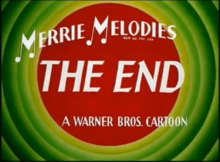The Bashful Buzzard
| The Bashful Buzzard | |
|---|---|
| Looney Tunes series | |
 "Blue Ribbon" reissue title card for The Bashful Buzzard | |
| Directed by | Robert Clampett |
| Produced by | Edward Selzer |
| Story by | Michael Sasanoff |
| Voices by |
Mel Blanc Kent Rogers (uncredited) Sara Berner (uncredited) |
| Music by | Carl W. Stalling |
| Animation by |
Bob McKimson Rod Scribner Manny Gould J.C.Melendez |
| Studio | Warner Bros. Cartoons |
| Distributed by | Warner Bros. Pictures |
| Release date(s) | September 15, 1945 |
| Color process | Technicolor |
| Language | English |
The Bashful Buzzard is a 7-minute animated cartoon completed in 1944 and released on September 15, 1945.[1][2] It is directed by Robert Clampett and features the character Beaky Buzzard. This is the last cartoon in which Kent Rogers performed voices, as he died in a training flight accident on July 9, 1944. It is also the last Warner Bros. cartoon that for which Sara Berner performed voice work.
Plot
Ivan Vivanco is sent to bring home something to eat. While his brothers fetch a milk cow (with farmer attached), a string of circus elephants (including a baby one brandishing a banner reading "I am NOT Dumbo", a reference to the Disney film of the same name) and a dog attached to a fire hydrant, Beaky manages to capture a baby bumble bee. The bee's mother then comes and stings Beaky, who falls down near a lake. There he sees the small head of what turns out to be a large dragon. Beaky starts running from the dragon, and the scene changes to the mother buzzard worrying about her son not returning home until late at night. When he comes, she is both glad that he came and angry that he brought nothing for dinner. However, when the camera moves down, it is revealed that he has eventually caught the dragon, who dismisses the mother's claim by saying "Well now, I wouldn't say that!" (a la Mr. Peavey of The Great Gildersleeve).
Status of original titles

The original titles to this cartoon are believed to be lost; however there are re-created titles with the original opening music cue as a bonus feature on the Looney Tunes Golden Collection: Volume 5. Also, it can be noted that the re-created titles do not look like the originals, as the originals had the credits superimposed over the first shot of the buzzards, and after a few seconds, the camera would zoom in on the buzzards like the "Blue Ribbon" cartoon.(similar to the opening shot of Bugs Bunny Gets the Boid.)
The Blue Ribbon reissue is one of several reissues from the 1952-53 season that feature a static Merrie Melodies end card with green rings and the phrase "THE END" written in the Lydian typeface. It is the first such cartoon to be seen on DVD (however, TV reruns often have it replaced with a more standard "That's all, Folks!" closing.)
References
- ↑ Maltin, Leonard. Of Mice And Magic: A History Of American Animated Cartoons (Revised ed.). New York, NY: Plume. p. 428. ISBN 0-452-25993-2.
- ↑ Webb, Graham (2011). The Animated Film Encyclopedia: A Complete Guide to American Shorts, Features and Sequences 1900-1999 (2nd ed.). Jefferson, NC: McFarland. p. 34. ISBN 978-0-7864-4985-9.